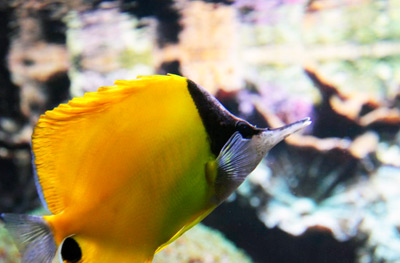You’ve heard time and again, here at Saltwater Smarts and elsewhere, that overfeeding is one of the surest ways to cause ill health in fish and pollute your aquarium water. The usual recommendation is to offer foods in very small quantities that the fish can consume within just a few minutes. And when it comes to reef systems, we tend to be especially sparing with fish food in order to maintain the lowest possible level of dissolved nutrients.
While it’s generally good advice to feed fish sparingly and judiciously, there are certain times when it doesn’t pay to be stingy with the victuals. In fact, sometimes you really have to feed on the heavy side and then step up your water changes and other water-quality-management techniques to compensate for the increased dissolved pollutants. Here are just a few examples off the top of my head:
When feeding a finicky fish in quarantine
Of course we’re supposed to make sure fish are eating at the LFS before we acquire them, but over the years I’ve had various specimens simply turn off the “feeding switch” upon arriving in quarantine (and in a few cases after being moved from quarantine into my display tank), possibly due to the stress of transfer or because they simply didn’t recognize the stuff I was offering as edible.
When this situation arises, it can take a lot of coaxing with different types of food at various times throughout the day to entice the specimen. In other words, you may end up introducing a lot more food to the system than is typically considered acceptable before the fish finally resumes feeding. But in this circumstance, it’s better to keep experimenting with different foods and compensating with stepped-up water changes, especially if you’re dealing with a specimen that has very little nutritional reserve to begin with—as is often the case with butterflyfishes, for example.
When a specimen is outcompeted at mealtimes
Another circumstance in which it may be necessary to suspend the rules on proper feeding, if only temporarily, is when a specimen is willing to eat whatever it’s presented but is too slow or skittish to get to any food before its tankmates do. This sometimes occurs when a specimen is newly introduced and hasn’t quite settled in to its new surroundings or figured out its role in the hierarchy yet. In this situation, despite its apparent appetite, the specimen could end up starving to death anyway unless something is done to change the feeding dynamic.
Sometimes my solution to this problem is to target feed the shy specimen (e.g., with a turkey baster), but if that’s not effective for one reason or another, I’ll try what I like to call “flooding the zone” with food. That is, I’ll put an oversized portion of, say, mysid shrimp right in front of a powerhead so a whole bunch of the little crustaceans are quickly dispersed throughout the entire tank. Since the greedy tankmates can’t be everywhere at once, this technique usually ensures that the shy feeder gets something to eat at every meal.
The fact that food is getting scattered throughout the whole tank means some of it may get trapped in the rockwork and decompose, so, again, the other half of the overfeeding equation is always to increase nutrient export through water changes, vigorous protein skimming, chemical filtration, etc.
What have I missed?
As I mentioned, these are just a few examples off the top of my head. If you can think of another circumstance in which overfeeding might be warranted, please share it in the comment section below.



